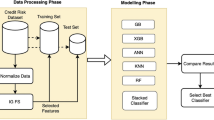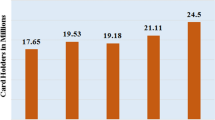Abstract
In this paper, we first compare the accuracies of the Recursive-Rule Extraction algorithm family, i.e., the Re-RX algorithm, its variant and the “Three-MLP Ensemble by the Re-RX algorithm” (shortened to “Three-MLP Ensemble”) using the Re-RX algorithm as a core part for six kinds of two-class mixed (i.e., discrete and continuous attributes) datasets. Two-class mixed datasets are commonly used for credit scoring and generally in financial domains. In this paper, we compare the accuracy by only the Re-RX algorithm family because of recent comparison reviews and benchmarking study results, obtained by complicated statistics, support vector machines, neuro-fuzzy hybrid classifications, and similar techniques. The Three-MLP Ensemble algorithm cascades standard backpropagation (BP) to train a three neural-network ensemble, where each neural network is a Multi-Layer Perceptron (MLP). Thus, strictly speaking, three neural networks do not need to be trained simultaneously. In addition, the Three-MLP Ensemble is a simple and new concept of rule extraction from neural network ensembles and can avoid previous complicated neural network ensemble structures and the difficulties of rule extraction algorithms. The extremely high accuracy of the Three-MLP Ensemble algorithm generally outperformed the Re-RX algorithm and the variant. The results confirm that the output from the network ensemble can be expressed in the form of rules, and thus opens the “black box” of trained neural network ensembles.
Access this chapter
Tax calculation will be finalised at checkout
Purchases are for personal use only
Preview
Unable to display preview. Download preview PDF.
Similar content being viewed by others
References
Setiono, R., et al.: Recursive neural network rule extraction for data with mixed attributes. IEEE Trans. Neural Netw. 19(2), 299–307 (2008)
Setiono, R., et al.: Rule extraction from minimal neural networks for credit card screening. Inter. J. of Neural Systems. 21(4), 265–276 (2011)
Quinlan, R.: C4.5: Programming for Machine Learning. Morgan Kaufman, San Mateo (1993)
Univ. of California, Irvine Learning Repository, http://archive.ics.uci.edu/m/
Bologna, G.: Is it worth generating rules from neural network ensemble? J. of Applied Logic 2, 325–348 (2004)
Hara, A., Hayashi, Y.: Ensemble neural network rule extraction using Re-RX algorithm. In: Proc. WCCI (IJCNN 2012), Brisbane, Australia, June 10-15, pp. 604–609 (2012)
Zhou, Z.-H.: Extracting symbolic rules from trained neural network ensembles. AI Communications 16, 3–15 (2003)
Hayashi, Y., et al.: A New approach to Three Ensemble neural network rule extraction using Recursive-Rule eXtraction algorithm. In: Int. Joint Conf. Neural Networks (IJCNN 2013), Dal-las, August 4-9, pp. 835–841 (2013)
Hayashi, Y.: Neural network rule extraction by a new ensemble concept and its theoretical and historical background: A review. Int. J. of Computational Intelligence and Applications 12(4), 1340006-1–1340006-22 (2013)
Setiono, R., et al.: A penalty-function approach for pruning feedforward neural networks. Neural Comp. 9(1), 185–204 (1997)
Setiono, R., et al.: A note on knowledge discovery using neural networks and its application to credit card screening. European J. Operational Research 192, 326–332 (2009)
Baesens, B., et al.: Using neural network rule extraction and decision tables for credit-risk evaluation. Management Science 49(3), 312–329 (2004)
Author information
Authors and Affiliations
Editor information
Editors and Affiliations
Rights and permissions
Copyright information
© 2014 Springer International Publishing Switzerland
About this paper
Cite this paper
Hayashi, Y., Tanaka, Y., Fujisawa, S., Izawa, T. (2014). Comparative Study of Accuracies on the Family of the Recursive-Rule Extraction Algorithm. In: Wermter, S., et al. Artificial Neural Networks and Machine Learning – ICANN 2014. ICANN 2014. Lecture Notes in Computer Science, vol 8681. Springer, Cham. https://doi.org/10.1007/978-3-319-11179-7_62
Download citation
DOI: https://doi.org/10.1007/978-3-319-11179-7_62
Publisher Name: Springer, Cham
Print ISBN: 978-3-319-11178-0
Online ISBN: 978-3-319-11179-7
eBook Packages: Computer ScienceComputer Science (R0)




